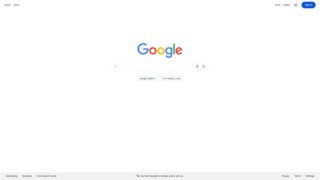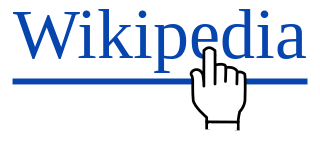Related Research Articles

Google Search is a search engine provided and operated by Google. Handling more than 3.5 billion searches per day, it has a 92% share of the global search engine market. It is the most-visited website in the world. Additionally, it is the most searched and used search engine in the entire world.
Spamdexing is the deliberate manipulation of search engine indexes. It involves a number of methods, such as link building and repeating unrelated phrases, to manipulate the relevance or prominence of resources indexed in a manner inconsistent with the purpose of the indexing system.
A web directory or link directory is an online list or catalog of websites. That is, it is a directory on the World Wide Web of the World Wide Web. Historically, directories typically listed entries on people or businesses, and their contact information; such directories are still in use today. A web directory includes entries about websites, including links to those websites, organized into categories and subcategories. Besides a link, each entry may include the title of the website, and a description of its contents. In most web directories, the entries are about whole websites, rather than individual pages within them. Websites are often limited to inclusion in only a few categories.
Search engine optimization (SEO) is the process of improving the quality and quantity of website traffic to a website or a web page from search engines. SEO targets unpaid traffic rather than direct traffic or paid traffic. Unpaid traffic may originate from different kinds of searches, including image search, video search, academic search, news search, and industry-specific vertical search engines.
Affiliate marketing is a marketing arrangement in which affiliates receive a commission for each visit, signup or sale they generate for a merchant. This arrangement allows businesses to outsource part of the sales process. It is a form of performance-based marketing where the commission acts as an incentive for the affiliate; this commission is usually a percentage of the price of the product being sold, but can also be a flat rate per referral.
Yahoo! Native is a native "Pay per click" Internet advertising service provided by Yahoo.
Pay-per-click (PPC) is an internet advertising model used to drive traffic to websites, in which an advertiser pays a publisher when the ad is clicked.

The anchor text, link label or link text is the visible, clickable text in an HTML hyperlink. The term "anchor" was used in older versions of the HTML specification for what is currently referred to as the a element, or <a>. The HTML specification does not have a specific term for anchor text, but refers to it as "text that the a element wraps around". In XML terms, the anchor text is the content of the element, provided that the content is text.
Search engine marketing (SEM) is a form of Internet marketing that involves the promotion of websites by increasing their visibility in search engine results pages (SERPs) primarily through paid advertising. SEM may incorporate search engine optimization (SEO), which adjusts or rewrites website content and site architecture to achieve a higher ranking in search engine results pages to enhance pay per click (PPC) listings and increase the Call to action (CTA) on the website.
In Web search engines, organic search results are the query results which are calculated strictly algorithmically, and not affected by advertiser payments. They are distinguished from various kinds of sponsored results, whether they are explicit pay per click advertisements, shopping results, or other results where the search engine is paid either for showing the result, or for clicks on the result.
The Sandbox effect is a name given to an observation of the way Google ranks web pages in its index. It is the subject of much debate—its existence has been written about since 2004, but not confirmed, with several statements to the contrary.

Danny Sullivan is an American technologist, journalist, and entrepreneur. He is the founder of Search Engine Watch in 1997, one of the earliest online publications about search engine marketing. He also launched Search Engine Strategies, one of the earliest search marketing trade shows. After selling both companies in 2006, he co-founded Search Engine Land, another search marketing publication. In 2017, he joined Google as an adviser at the search division of the company.
Social media optimization (SMO) is the use of a number of outlets and communities to generate publicity to increase the awareness of a product, service brand or event. Types of social media involved include RSS feeds, social news, bookmarking sites, and social networking sites such as Facebook, Instagram, Twitter, video sharing websites, and blogging sites. SMO is similar to search engine optimization (SEO) in that the goal is to generate web traffic and increase awareness for a website. SMO's focal point is on gaining organic links to social media content. In contrast, SEO's core is about reaching the top of the search engine hierarchy. In general, social media optimization refers to optimizing a website and its content to encourage more users to use and share links to the website across social media and networking sites.
In the field of search engine optimization (SEO), link building describes actions aimed at increasing the number and quality of inbound links to a webpage with the goal of increasing the search engine rankings of that page or website. Briefly, link building is the process of establishing relevant hyperlinks to a website from external sites. Link building can increase the number of high-quality links pointing to a website, in turn increasing the likelihood of the website ranking highly in search engine results. Link building is also a proven marketing tactic for increasing brand awareness.
Quality Score is a metric used by Google, Yahoo!, Facebook and Bing that influences the ad rank and cost per click (CPC) of ads.
Search neutrality is a principle that search engines should have no editorial policies other than that their results be comprehensive, impartial and based solely on relevance. This means that when a user types in a search engine query, the engine should return the most relevant results found in the provider's domain, without manipulating the order of the results, excluding results, or in any other way manipulating the results to a certain bias.
Native advertising, also called sponsored content, partner content, and branded journalism, is a type of paid advertising that appears in the style and format of the content near the advertisement's placement. It manifests as a post, image, video, article or editorial piece of content. In some cases it functions like an advertorial. The word native refers to this coherence of the content with the other media that appear on the platform.
Hummingbird is the codename given to a significant algorithm change in Google Search in 2013. Its name was derived from the speed and accuracy of the hummingbird. The change was announced on September 26, 2013, having already been in use for a month. "Hummingbird" places greater emphasis on natural language queries, considering context and meaning over individual keywords. It also looks deeper at content on individual pages of a website, with improved ability to lead users directly to the most appropriate page rather than just a website's homepage.
Google Search, offered by Google, is the most widely used search engine on the World Wide Web as of 2023, with over eight billion searches a day. This page covers key events in the history of Google's search service.
Google PageSpeed is a family of tools by Google Inc, designed to help a website's performance optimizations. It was introduced at Developer Conference in 2010. There are four main components of PageSpeed family tools: PageSpeed Module, consisting of mod PageSpeed for the Apache HTTP Server and ngx PageSpeed for the Nginx, PageSpeed Insights, PageSpeed Service, and PageSpeed Chrome DevTools extension. All of these components are built to identify the faults in a website's compliance with Google's Web Performance Best Practices, and automate the optimization process.
References
- ↑ "UNITED STATES OF AMERICA FEDERAL TRADE COMMISSION WASHINGTON, D.C. 20580". FTC. Archived from the original on 23 July 2013. Retrieved 5 July 2013.
- ↑ Kritzinger, W. T.; Weideman, M. (2013-07-03). "Search Engine Optimization and Pay-per-Click Marketing Strategies". Journal of Organizational Computing and Electronic Commerce. 23 (3): 273–286. doi:10.1080/10919392.2013.808124. ISSN 1091-9392.
- 1 2 Sullivan, Danny. "The Evolution of Paid Inclusion". searchenginewatch. Archived from the original on 4 July 2013. Retrieved 6 July 2013.
- 1 2 Sullivan, Danny (June 2004). "The Paid Inclusion Dinosaur" . Retrieved 6 July 2013.
- ↑ Ulbrich, Chris. "Paid Inclusion Losing Charm?". Wired . Retrieved 6 July 2013.
- ↑ Sullivan, Danny (30 May 2012). "Once Deemed Evil, Google Now Embraces "Paid Inclusion"". marketingland.com. Retrieved 6 July 2013.
- ↑ Wall, Aaron. "Google Paid Inclusion Programs: Buy a Top Ranking Today" . Retrieved 6 July 2013.
- ↑ Lee, Kevin (22 June 2012). "4 Ways to Prepare for Google's Paid Inclusion Hybrid" . Retrieved 6 July 2013.
- ↑ Mara, janis (July 2004). "MSN Updates Search, Drops Paid Inclusion" . Retrieved 6 July 2013.
- ↑ 15 U.S.C. § 45(a)(1)
- ↑ Sullivan, Danny (8 June 2012). "Given Nextag's Lack Of Transparency, Its WSJ Opinion Piece Asking For Google Transparency Isn't Wise". searchengineland. Retrieved 6 July 2013.
- ↑ Sullivan, Danny (21 December 2011). "Dear Congress: It's Not OK Not To Know How Search Engines Work, Either". searchengineland. Retrieved 6 July 2013.
- ↑ Sullivan, Danny (19 July 2012). "On Google Earnings Call, Google Ignores FTC Definition Of "Paid Inclusion"". searchengineland. Retrieved 6 July 2013.